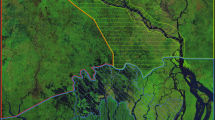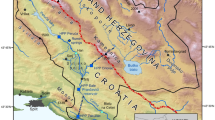Abstract
Previous accounts and recent observations indicate that the pattern and geometry of the Omo River meanders in the Lower Omo basin of Ethiopia had already been established in earlier times by large floods that took place after extended periods of drought. The cross-sectional changes resulted from floods in the nineteenth and twentieth centuries, were then simply limited to small degree channel widening and entrenchment, and floodplain erosion and deposition. The effects of the August 2006 flood, although widespread and destructive for the environment, were also modest as far as adjusting the channel pattern is concerned. Changes in channel profiles at short-term scales usually come in the form of aggradation and degradation. Interpretations of satellite images taken before and after the flood showed the accumulation of coarse sediments in the channel. There are also some sporadic indications for an increase in channel width. Widening in response to high amount of discharges can generally be expected during floods. Besides, signs of channel shortening were observed in some places. Apart from these minor changes, the dimension of meandering segments or the outline of the entire meander belt, and the basic morphology of the channel remained unaffected.








Similar content being viewed by others
References
Ackers P, Charlton FG (1970) Meander geometry arising from varying flows. J Hydrol 11:230–252
Butzer KW (1970) Contemporary depositional environments of the Omo delta. Nature 226:425–430
Butzer KW (1971a) The Lower Omo basin: geology, fauna and hominids of the Plio–Pleistocene Formations. Naturwissenschaften 58:7–16
Butzer KW (1971b) Recent history of an Ethiopian delta: the Omo River and the level of Lake Rudolf (Turkana). The University of Chicago, Department of Geography, Research paper No 136, p 184
Butzer KW, Thurber DL (1969) Some Late Cenozoic sedimentary formations of the Lower Omo basin. Nature 222:1138–1143
Butzer KW, Brown FH, Thurber DL (1970) Horizontal sediments of the Lower Omo valley: the Kibishi Formation. Quaternaria 11:15–30
Carr CJ (1998) Patterns of vegetation along the Omo River in southwest Ethiopia. Plant Ecol 135:13–163
De Heinzelin J, Brown FH, Howell FC (1971) Pliocene–Pleistocene Formations in the Lower Omo basin, southern Ethiopia. Quaternaria 13:247–268
Forte F, Strobl RO, Pennetta L (2006) A methodology using GIS, aerial photos and remote sensing for loss estimation and flood vulnerability analysis in the Supersano–Ruffano–Nociglia Graben, Southern Italy. Environ Geol 50:581–594
Gomez B, Marron DC (1991) Neotectonic effects on sinuosity and channel migration, Belle Fourche River, western South Dakota. Earth Surf Process Landf 16:227–235
Gregory KJ, Walling DE (1973) Drainage basin form and process: a geomorphological approach. Edward Arnold, London, p 456
Haack B (1996) Monitoring wetland changes with an East African example. Environ Manage 20:411–419
Harun R, Pramanik MAH (1993) Areal extent of the 1988 flood in Bangladesh: how much did the satellite imagery show? Nat Hazard 8:189–200
Hickin EJ, Nanson GC (1984) Lateral migration rates of river bends. J Hydraul Eng 110:1557–1567
Hooke JM (1995) River channel adjustment to meander cutoffs on the River Bollin and River Dane, northwest England. Geomorphology 14:235–253
Islam MM, Sado K (2000) Flood hazard assessment in Bangladesh using NOAA AVHRR data with geographical information system. Hydrol Process 14:605–620
Knox JC (1993) Large increases in flood magnitude in response to modest changes in climate. Nature 361:430–432
Lewis GW, Lewin J (1983) Alluvial cutoffs in Wales and the Borderlands. Spec Publ Int Ass Sedimentol 6:145–154
Matthes GH (1941) Basic aspects of stream meanders. Trans Am Geophys Union 22:632–636
Puech C, Raclot D (2002) Using geographical information systems and aerial photographs to determine water levels during floods. Hydrol Process 16:1593–1602
Sakalowsky PP (1974) Theories of stream meander causation: a review and analysis. Earth Sci Rev 10:121–138
Sanyal J, Lu XX (2005) Remote sensing and GIS-based flood vulnerability assessment of human settlements: a case study of Gangetic West Bengal, India. Hydrol Process 19:3699–3716
Schumm SA (1963) Sinuosity of alluvial rivers on the Great Plains. Geol Soc Am Bull 74:1089–1100
Van der Sande CJ, De Jong SM, De Roo APJ (2003) A segmentation and classification approach of IKONOS-2 imagery for land cover mapping to assist flood risk and flood damage assessment. Int J Appl Earth Obs Geoinf 4:217–229
Verschuren D, Laird KR, Cumming BF (2000) Rainfall and drought in equatorial east Africa during the past 1,100 years. Nature 403:410–414
Wood CA, Lovett R (1974) Rainfall, drought and the solar cycle. Nature 251:594–596
Yang CT (1971) On river meanders. J Hydrol 13:231–253
Acknowledgments
I am grateful to the Alexander von Humboldt Foundation for financing the research stay which led to the preparation of this article, and to the Ethiopian Metrological Agency for making unpublished climatic data freely available for scientific studies. I have to thank also Lidya and Abel for staying quiet while I was away from home for this study.
Author information
Authors and Affiliations
Corresponding author
Rights and permissions
About this article
Cite this article
Ayalew, L. Analyzing the effects of historical and recent floods on channel pattern and the environment in the Lower Omo basin of Ethiopia using satellite images and GIS. Environ Geol 58, 1713–1726 (2009). https://doi.org/10.1007/s00254-008-1671-8
Received:
Accepted:
Published:
Issue Date:
DOI: https://doi.org/10.1007/s00254-008-1671-8




